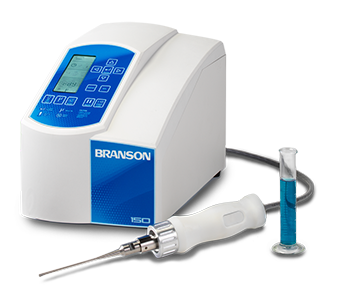Ultrasonic homogenizers, as well as other types of ultrasonic equipment, such as ultrasonic baths, typically operate at a single frequency. You may come across a few that enable you to select a frequency, but these will normally just have two options. In this post, we’ll delve into the details of why this is the case.
Ultrasonic Homogenizers and Resonance
An ultrasonic homogenizer consists of the following three parts:
- Generator: This provides and controls the power.
- Transducer (or converter): The transducer contains piezoelectric crystals that convert electrical energy to high-frequency mechanical motion. The converter also amplifies the signal.
- Titanium probe (or “horn”): The probe vibrates rapidly in a longitudinal direction, transmitting ultrasonic energy to the sample.
The homogenizer operates based on resonance. A resonant frequency of a vibrating object is its natural frequency of vibration and depends of the physical parameters of the object. The resonant frequency of the transducer and the probe must be in tune for the ultrasonic homogenizer to work.
If the frequency is changed, the system will no longer be in resonance. This will cause the probe to stop vibrating, rendering the system useless. This is also a reason why switching between different sized probes is not possible. If the length of the probe is changed, the system won’t be in resonance. Similarly, a probe that is damaged (perhaps due to a fracture or cavitation erosion) will no longer be suitable as its resonant frequency will have changed.
Frequency in Practice
Most ultrasonic homogenizers operate at around 20 kHz, which means that the horn completes 20,000 vibration cycles each second. However, some have a higher frequency, such as the Sonifier® SFX150 (below) with a frequency of 40 kHz.

Note that the frequency you see within the manufacturer specifications of your unit may not be the exact frequency it’s operating at. As mentioned, resonant frequency is determined by multiple physical parameters. The resonant frequency of the piezoelectric material in the transducer is altered with fluctuations in temperature and other external factors.
Newer ultrasonic homogenizers are automatically tuned to their optimal resonant frequency. During operation, the generator tracks the frequency of the horn and automatically adjusts it. This means, for example, that at a given time, the actual frequency of a 20 kHz ultrasonic homogenizer may be anywhere between 19.5–20.5 kHz.

This snippet is from the description of the Sonifier® S-450 Analog (shown above): “The broadband tuning feature precisely adjusts the 20 kHz output frequency to optimum levels even when process tooling is changed.” This refers to the Autotune plus Memory (AT/M) feature (also found in the Sonifier® S-250 Analog) which provides automatic tuning and stores the frequency after each cycle. Many older generators don't have a similar function and require manual tuning.
